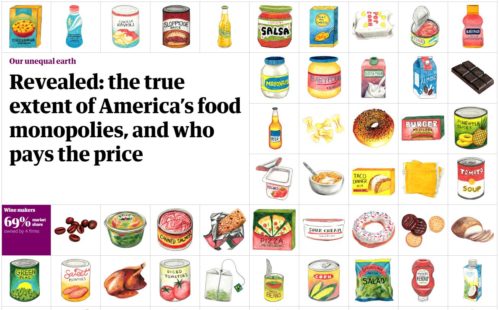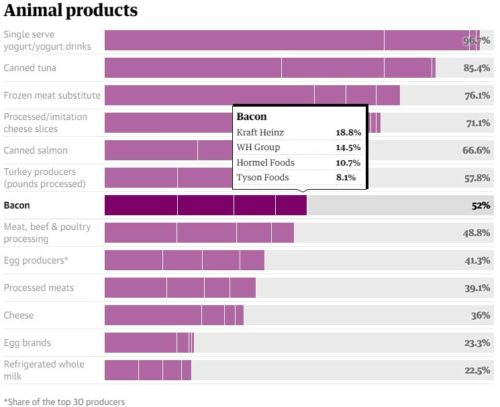America’s food monopolies and power imbalances
The Guardian and Food and Water Watch have produced a lengthy, interactive, and fact-filled investigative report, essential reading for anyone interested in how power is distributed in the US food system.

The report is a about how consolidation has increased the power of every segment of the food industry, and how that power imbalance threatens workers, consumers, and American democracy.
The size, power and profits of these mega companies have expanded thanks to political lobbying and weak regulation which enabled a wave of unchecked mergers and acquisitions. This matters because the size and influence of these mega-companies enables them to largely dictate what America’s 2 million farmers grow and how much they are paid, as well as what consumers eat and how much our groceries cost.
Here are some of the facts (and the Guardian summarizes others in an article on “The Illusion of Choice“):
- At least half of the 10 lowest-paid jobs are in the food industry. Farms and meat processing plants are among the most dangerous and exploitative workplaces in the country.
- Overall, only 15 cents of every dollar we spend in the supermarket goes to farmers. The rest goes to processing and marketing our food.
- Four firms or fewer controlled at least 50% of the market for 79% of the groceries. For almost a third of shopping items, the top firms controlled at least 75% of the market share.
- During the 2020 election cycle, the food industry spent $175m on political contributions, including lobbying by PACs and individuals and other efforts.
- Until the 1990s, most people shopped in local or regional grocery stores. Now, just four companies – Walmart, Costco, Kroger and Ahold Delhaize – control 65% of the retail market.
- Farmers received $424.4bn in subsidies between 1995 and 2020, of which 49% were for just three crops: corn, wheat and soybeans, according to the Environmental Working Group. Corn subsidies are the largest by a long way – $116.6bn – accounting for 27% of the total.
- At least half of the 10 lowest-paid jobs in the US are in the food industry, and they rely disproportionately on federal benefits. Walmart and McDonald’s are among the top employers of beneficiaries of food stamps and Medicaid, according to a 2020 study by a non-partisan government watchdog.
- Here in the US, there were 1.6bn animals living on 25,000 factory farms in 2017 – a 14% rise in just five years. Together, these animals produced about 885bn pounds of manure annually – equivalent to the human sewage generated by residents of 30 New York Cities.


